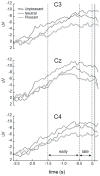Preparing to grasp emotionally laden stimuli
- PMID: 23024811
- PMCID: PMC3443242
- DOI: 10.1371/journal.pone.0045235
Preparing to grasp emotionally laden stimuli
Abstract
Background: Contemporary theories of motor control propose that motor planning involves the prediction of the consequences of actions. These predictions include the associated costs as well as the rewarding nature of movements' outcomes. Within the estimation of these costs and rewards would lie the valence, that is, the pleasantness or unpleasantness of a given stimulus with which one is about to interact. The aim of this study was to test if motor preparation encompasses valence.
Methodology/principal findings: The readiness potential, an electrophysiological marker of motor preparation, was recorded before the grasping of pleasant, neutral and unpleasant stimuli. Items used were balanced in weight and placed inside transparent cylinders to prompt a similar grip among trials. Compared with neutral stimuli, the grasping of pleasant stimuli was preceded by a readiness potential of lower amplitude, whereas that of unpleasant stimuli was associated with a readiness potential of higher amplitude.
Conclusions/significance: We show for the first time that the sensorimotor cortex activity preceding the grasping of a stimulus is affected by its valence. Smaller readiness potential amplitudes found for pleasant stimuli could imply in the recruitment of pre-set motor repertoires, whereas higher amplitudes found for unpleasant stimuli would emerge from a discrepancy between the required action and their aversiveness. Our results indicate that the prediction of action outcomes encompasses an estimate of the valence of a stimulus with which one is about to interact.
Conflict of interest statement
Figures


Similar articles
-
Corticospinal excitability preceding the grasping of emotion-laden stimuli.PLoS One. 2014 Apr 14;9(4):e94824. doi: 10.1371/journal.pone.0094824. eCollection 2014. PLoS One. 2014. PMID: 24732961 Free PMC article.
-
Cerebral blood flow changes associated with attribution of emotional valence to pleasant, unpleasant, and neutral visual stimuli in a PET study of normal subjects.Am J Psychiatry. 1999 Oct;156(10):1618-29. doi: 10.1176/ajp.156.10.1618. Am J Psychiatry. 1999. PMID: 10518175
-
Motor planning of goal-directed action is tuned by the emotional valence of the stimulus: a kinematic study.Sci Rep. 2016 Jul 1;6:28780. doi: 10.1038/srep28780. Sci Rep. 2016. PMID: 27364868 Free PMC article.
-
Right ventromedial prefrontal lesions result in paradoxical cardiovascular activation with emotional stimuli.Brain. 2006 Dec;129(Pt 12):3343-55. doi: 10.1093/brain/awl299. Epub 2006 Nov 1. Brain. 2006. PMID: 17082198
-
Steady-state visually evoked potential topography during processing of emotional valence in healthy subjects.Neuroimage. 2002 Dec;17(4):1684-92. doi: 10.1006/nimg.2002.1298. Neuroimage. 2002. PMID: 12498742 Clinical Trial.
Cited by
-
Temporal dynamics of motor cortex excitability during perception of natural emotional scenes.Soc Cogn Affect Neurosci. 2014 Oct;9(10):1451-7. doi: 10.1093/scan/nst139. Epub 2013 Aug 14. Soc Cogn Affect Neurosci. 2014. PMID: 23945998 Free PMC article.
-
Corticospinal excitability preceding the grasping of emotion-laden stimuli.PLoS One. 2014 Apr 14;9(4):e94824. doi: 10.1371/journal.pone.0094824. eCollection 2014. PLoS One. 2014. PMID: 24732961 Free PMC article.
-
How you perceive threat determines your behavior.Front Hum Neurosci. 2013 Oct 8;7:632. doi: 10.3389/fnhum.2013.00632. eCollection 2013. Front Hum Neurosci. 2013. PMID: 24115925 Free PMC article.
-
Bad things come easier to the mind but harder to the body: Evidence from brain oscillations.Cogn Affect Behav Neurosci. 2016 Aug;16(4):768-78. doi: 10.3758/s13415-016-0429-0. Cogn Affect Behav Neurosci. 2016. PMID: 27383376
-
Neural underpinnings of the interplay between actual touch and action imagination in social contexts.Front Hum Neurosci. 2024 Jan 11;17:1274299. doi: 10.3389/fnhum.2023.1274299. eCollection 2023. Front Hum Neurosci. 2024. PMID: 38292652 Free PMC article.
References
Publication types
MeSH terms
LinkOut - more resources
Full Text Sources

